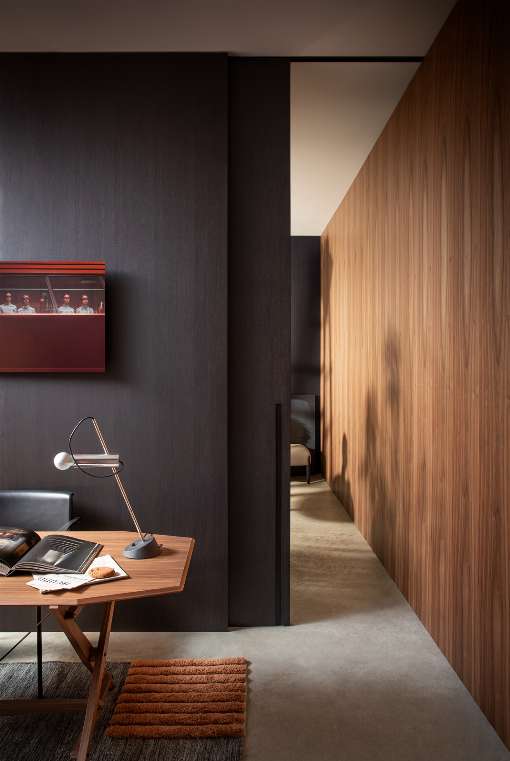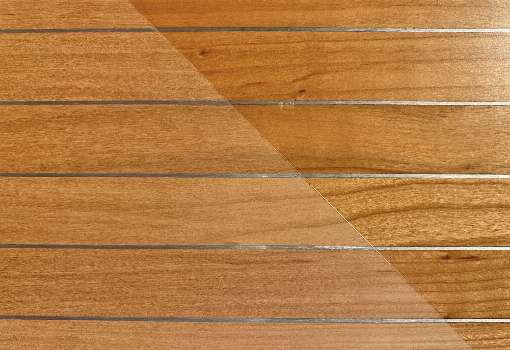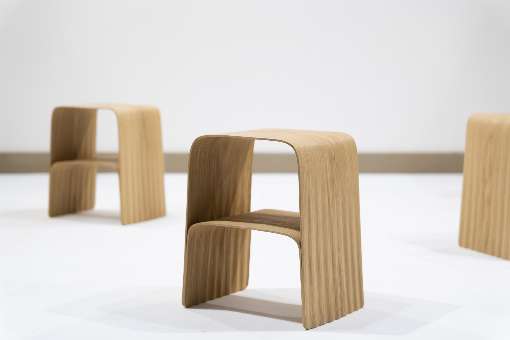18.01.2023
Veneer combines nature and trends:
Bonn. Veneer has always been the most economical application form of real wood. It is thinly sliced from the tree trunk with a sharp knife, without any significant residue. This makes it the thinnest solid wood in the world. One cubic meter of wood yields an average of 400 m² of veneer. Furniture surfaces for twelve bedrooms can be made from it. Whether oak, walnut or softwood, veneer is enormously resource-efficient and is currently experiencing a real boom. "The climate crisis is reinforcing a growing environmental awareness among people, leading to a change in consumption and stimulating demand for ecological and sustainable products. And this is not about fads or short-term trends," says Ursula Geismann, a longtime trend analyst and managing director of Initiative Furnier + Natur (IFN), "it's about a megatrend that is becoming a real conviction."
At the moment, so-called "greenwashing" is occurring in many consumer and capital goods sectors, as all manufacturers want to keep up with this trend, but can't always. "Wood has the natural advantage of storing CO2 within itself. It comes from sustainable forestry in Europe and thus alone fulfills two important criteria that make for an ecologically sustainable product," says Geismann. Added to this is the increasingly important disposal of products. Here, too, wood scores points with its possible reuse, for example in the DIY sector or in the waste wood industry, with its conceivable compostability, and finally with its thermal utilization for the generation of heat and energy. This makes wood and its veneer the material of a climate-friendly future. Here is a look at the latest veneer trends:
Areas of application for veneer are growing
Bank cards, hotel cards, business cards, placemats, DIY adhesive veneer, packaging, forks and knives, espresso cups, plates... More and more ideas are coming onto the market in which real wood veneer replaces plastics, coated papers, foils or varnishes as an ecological material alternative. Thick veneers, from which furniture can be built by bending and without an additional material, are also in vogue.
Metal threads expand the range of applications
The latest trend is so-called metal inlays, which are inserted into veneer. This combination used to be possible only with elaborate handwork and simple patterns. Today, digital technologies allow graphic patterns, logos or imaginative ornaments in a single process step. The greatly expanded spectrum of the natural material veneer thus scores points in interior design, for high-quality furniture surfaces or as an eye-catcher in cars.
Boiserie returns with exciting looks
Boiserie, the paneling of walls and ceilings with veneer, was widespread until the 18th century. Paneling had a small resurgence in the 1960s, but was often considered too boring after that. This attitude is undergoing a reversal. On the one hand, because wall paneling made of veneer serves as thermal insulation and soundproofing, and on the other hand, because their appearance is now much more diverse and modern. Very chic can be integrated tasteful, floor-to-ceiling doors with block frames or elegant sliding doors.
Printed veneers score particularly well in stores
Veneers produce different images depending on how they are put together. Surfaces can thus be designed to be intentionally restless or calm. Around 150 wood species are available as veneers. Most of them can be printed according to individual specifications. Decorative prints such as organic paisley and mandala patterns are in vogue, as are geometric prints with corners and edges on a uniform color background. Internationally active brands from various consumer goods sectors like to opt for uniform colors and logos for the veneer used in the interiors and furniture of their retail stores.
It doesn't always have to be oak
In addition to oak, the light wood of maple, the medium to dark brown and elegant American walnut and the calm and yellowish light birch score highly in the veneer ranking. In addition, demand for European ash veneer is growing, and beech veneers with a reddish tinge are once again asserting themselves more clearly on the market. Eucalyptus, which likes to be smoked, is coming along as an exclusive trend veneer. "Buyers of veneer are increasingly accepting the growth characteristics of wood, such as branching or medullary rays, as natural and individual. Another trend set by this unique natural material," concludes the IFN managing director. IFN/UG
Further information on the subject of veneer at www.furnier.de or
facebook
linkedin
instagram
Image 1: Boiserie is experiencing a renaissance. Photo: IFN/Lualdi
Image 2: Metal inlays are very much in vogue. Photo: IFN
Image 3: Chic stool made of veneer. Photo: IFN/Kouichi Kurome, Japan
January 18, 2023
Veneer combines nature and trends:
The fillet of the tree is ecological and beautiful
Bonn. Veneer has always been the most economical application form of real wood. It is thinly sliced from the tree trunk with a sharp knife, without any significant residue. This makes it the thinnest solid wood in the world. One cubic meter of wood yields an average of 400 m² of veneer. Furniture surfaces for twelve bedrooms can be made from it. Whether oak, walnut or softwood, veneer is enormously resource-efficient and is currently experiencing a real boom. "The climate crisis is reinforcing a growing environmental awareness among people, leading to a change in consumption and stimulating demand for ecological and sustainable products. And this is not about fads or short-term trends," says Ursula Geismann, a longtime trend analyst and managing director of Initiative Furnier + Natur (IFN), "it's about a megatrend that is becoming a real conviction."
At the moment, so-called "greenwashing" is occurring in many consumer and capital goods sectors, as all manufacturers want to keep up with this trend, but can't always. "Wood has the natural advantage of storing CO2 within itself. It comes from sustainable forestry in Europe and thus alone fulfills two important criteria that make for an ecologically sustainable product," says Geismann. Added to this is the increasingly important disposal of products. Here, too, wood scores points with its possible reuse, for example in the DIY sector or in the waste wood industry, with its conceivable compostability, and finally with its thermal utilization for the generation of heat and energy. This makes wood and its veneer the material of a climate-friendly future. Here is a look at the latest veneer trends:
Areas of application for veneer are growing
Bank cards, hotel cards, business cards, placemats, DIY adhesive veneer, packaging, forks and knives, espresso cups, plates... More and more ideas are coming onto the market in which real wood veneer replaces plastics, coated papers, foils or varnishes as an ecological material alternative. Thick veneers, from which furniture can be built by bending and without an additional material, are also in vogue.
Metal threads expand the range of applications
The latest trend is so-called metal inlays, which are inserted into veneer. This combination used to be possible only with elaborate handwork and simple patterns. Today, digital technologies allow graphic patterns, logos or imaginative ornaments in a single process step. The greatly expanded spectrum of the natural material veneer thus scores points in interior design, for high-quality furniture surfaces or as an eye-catcher in cars.
Boiserie returns with exciting looks
Boiserie, the paneling of walls and ceilings with veneer, was widespread until the 18th century. Paneling had a small resurgence in the 1960s, but was often considered too boring after that. This attitude is undergoing a reversal. On the one hand, because wall paneling made of veneer serves as thermal insulation and soundproofing, and on the other hand, because their appearance is now much more diverse and modern. Very chic can be integrated tasteful, floor-to-ceiling doors with block frames or elegant sliding doors.
Printed veneers score particularly well in stores
Veneers produce different images depending on how they are put together. Surfaces can thus be designed to be intentionally restless or calm. Around 150 wood species are available as veneers. Most of them can be printed according to individual specifications. Decorative prints such as organic paisley and mandala patterns are in vogue, as are geometric prints with corners and edges on a uniform color background. Internationally active brands from various consumer goods sectors like to opt for uniform colors and logos for the veneer used in the interiors and furniture of their retail stores.
It doesn't always have to be oak
In addition to oak, the light wood of maple, the medium to dark brown and elegant American walnut and the calm and yellowish light birch score highly in the veneer ranking. In addition, demand for European ash veneer is growing, and beech veneers with a reddish tinge are once again asserting themselves more clearly on the market. Eucalyptus, which likes to be smoked, is coming along as an exclusive trend veneer. "Buyers of veneer are increasingly accepting the growth characteristics of wood, such as branching or medullary rays, as natural and individual. Another trend set by this unique natural material," concludes the IFN managing director. IFN/UG
Further information on the subject of veneer at www.furnier.de or
Image 1: Boiserie is experiencing a renaissance. Photo: IFN/Lualdi
Image 2: Metal inlays are very much in vogue. Photo: IFN
Image 3: Chic stool made of veneer. Photo: IFN/Kouichi Kurome, Japan
January 18, 2023


